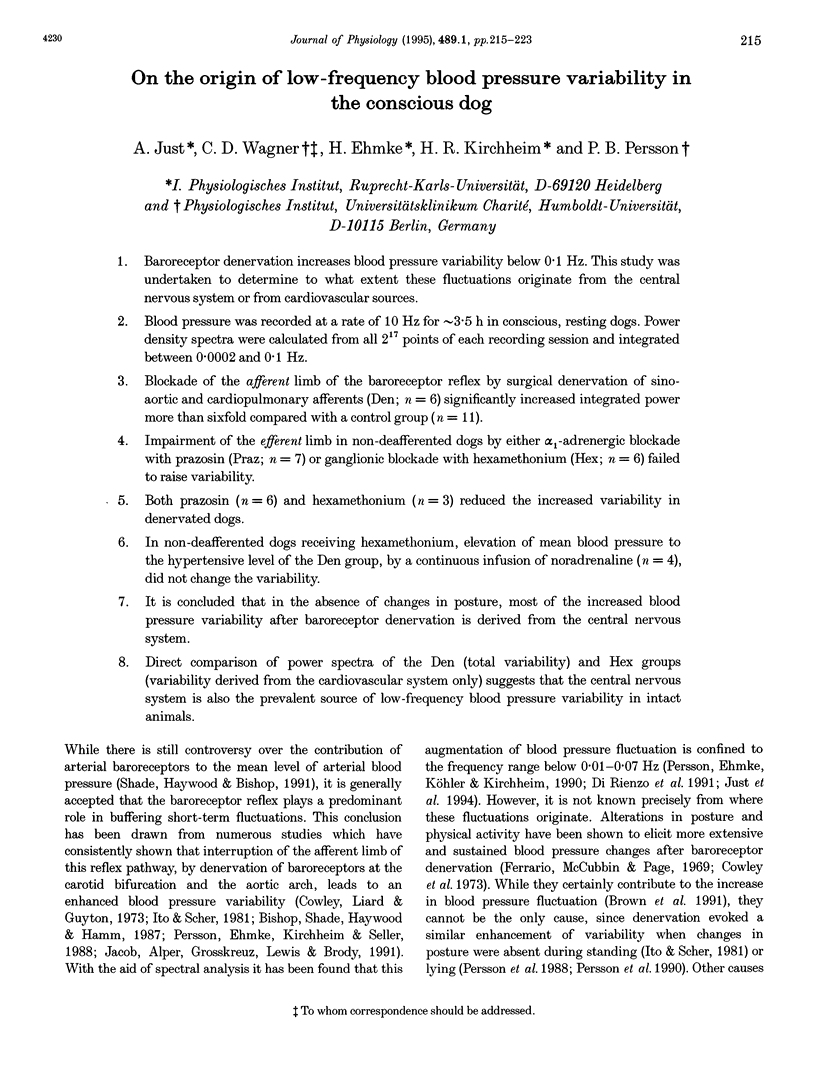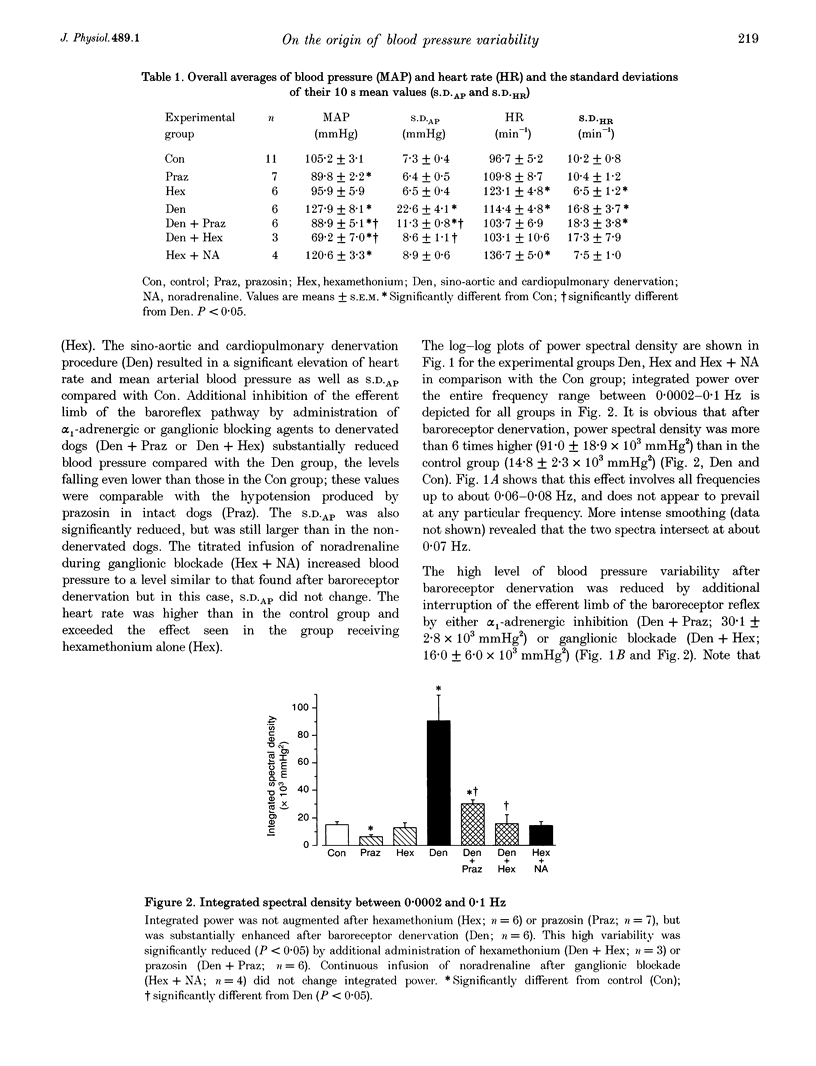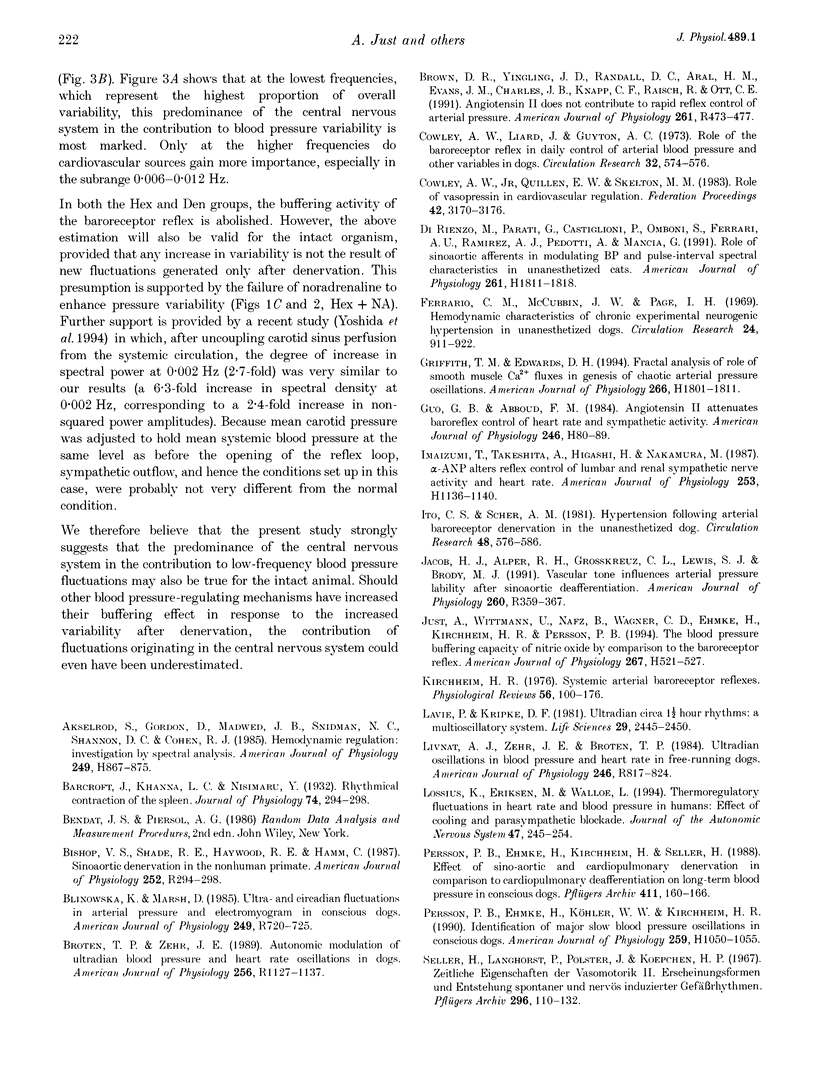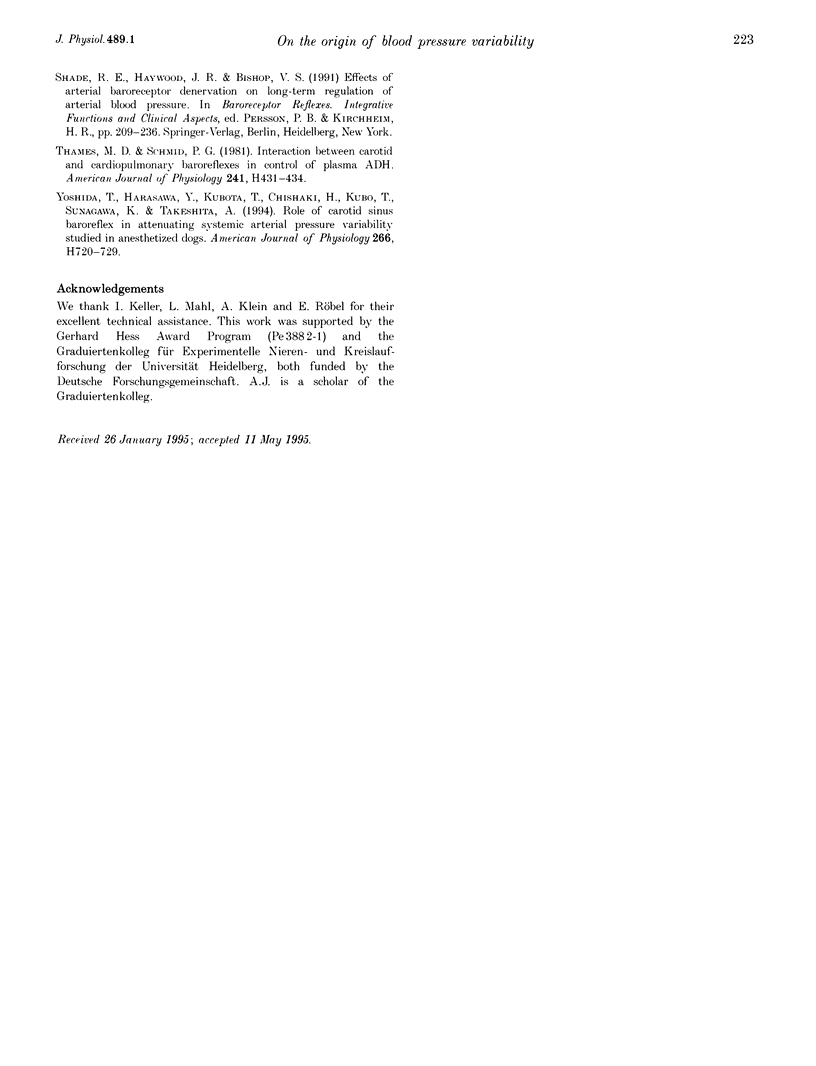Abstract
1. Baroreceptor denervation increases blood pressure variability below 0.1 Hz. This study was undertaken to determine to what extent these fluctuations originate from the central nervous system or from cardiovascular sources. 2. Blood pressure was recorded at a rate of 10 Hz for approximately 3.5 h in conscious, resting dogs. Power density spectra were calculated from all 2(17) points of each recording session and integrated between 0.0002 and 0.1 Hz. 3. Blockade of the afferent limb of the baroreceptor reflex by surgical denervation of sinoaortic and cardiopulmonary afferents (Den; n = 6) significantly increased integrated power more than sixfold compared with a control group (n = 11). 4. Impairment of the efferent limb in non-deafferented dogs by either alpha 1-adrenergic blockade with prazosin (Praz; n = 7) or ganglionic blockade with hexamethonium (Hex; n = 6) failed to raise variability. 5. Both prazosin (n = 6) and hexamethonium (n = 3) reduced the increased variability in denervated dogs. 6. In non-deafferented dogs receiving hexamethonium, elevation of mean blood pressure to the hypertensive level of the Den group, by a continuous infusion of noradrenaline (n = 4), did not change the variability. 7. It is concluded that in the absence of changes in posture, most of the increased blood pressure variability after baroreceptor denervation is derived from the central nervous system. 8. Direct comparison of power spectra of the Den (total variability) and Hex groups (variability derived from the cardiovascular system only) suggests that the central nervous system is also the prevalent source of low-frequency blood pressure variability in intact animals.
Full text
PDF








Selected References
These references are in PubMed. This may not be the complete list of references from this article.
- Akselrod S., Gordon D., Madwed J. B., Snidman N. C., Shannon D. C., Cohen R. J. Hemodynamic regulation: investigation by spectral analysis. Am J Physiol. 1985 Oct;249(4 Pt 2):H867–H875. doi: 10.1152/ajpheart.1985.249.4.H867. [DOI] [PubMed] [Google Scholar]
- Barcroft J., Khanna L. C., Nisimaru Y. Rhythmical contraction of the spleen. J Physiol. 1932 Mar 7;74(3):294–298. doi: 10.1113/jphysiol.1932.sp002848. [DOI] [PMC free article] [PubMed] [Google Scholar]
- Bishop V. S., Shade R. E., Haywood J. R., Hamm C. Sinoaortic denervation in the nonhuman primate. Am J Physiol. 1987 Feb;252(2 Pt 2):R294–R298. doi: 10.1152/ajpregu.1987.252.2.R294. [DOI] [PubMed] [Google Scholar]
- Brown D. R., Yingling J. D., Randall D. C., Aral H. M., Evans J. M., Charles J. B., Knapp C. F., Raisch R., Ott C. E. Angiotensin II does not contribute to rapid reflex control of arterial pressure. Am J Physiol. 1991 Aug;261(2 Pt 2):R473–R477. doi: 10.1152/ajpregu.1991.261.2.R473. [DOI] [PubMed] [Google Scholar]
- Cowley A. W., Jr, Liard J. F., Guyton A. C. Role of baroreceptor reflex in daily control of arterial blood pressure and other variables in dogs. Circ Res. 1973 May;32(5):564–576. doi: 10.1161/01.res.32.5.564. [DOI] [PubMed] [Google Scholar]
- Cowley A. W., Jr, Quillen E. Q., Jr, Skelton M. M. Role of vasopressin in cardiovascular regulation. Fed Proc. 1983 Dec;42(15):3170–3176. [PubMed] [Google Scholar]
- Di Rienzo M., Parati G., Castiglioni P., Omboni S., Ferrari A. U., Ramirez A. J., Pedotti A., Mancia G. Role of sinoaortic afferents in modulating BP and pulse-interval spectral characteristics in unanesthetized cats. Am J Physiol. 1991 Dec;261(6 Pt 2):H1811–H1818. doi: 10.1152/ajpheart.1991.261.6.H1811. [DOI] [PubMed] [Google Scholar]
- Ferrario C. M., McCubbin J. W., Page I. H. Hemodynamic characteristics of chronic experimental neurogenic hypertension in unanesthetized dogs. Circ Res. 1969 Jun;24(6):911–922. doi: 10.1161/01.res.24.6.911. [DOI] [PubMed] [Google Scholar]
- Griffith T. M., Edwards D. H. Fractal analysis of role of smooth muscle Ca2+ fluxes in genesis of chaotic arterial pressure oscillations. Am J Physiol. 1994 May;266(5 Pt 2):H1801–H1811. doi: 10.1152/ajpheart.1994.266.5.H1801. [DOI] [PubMed] [Google Scholar]
- Guo G. B., Abboud F. M. Angiotensin II attenuates baroreflex control of heart rate and sympathetic activity. Am J Physiol. 1984 Jan;246(1 Pt 2):H80–H89. doi: 10.1152/ajpheart.1984.246.1.H80. [DOI] [PubMed] [Google Scholar]
- Imaizumi T., Takeshita A., Higashi H., Nakamura M. alpha-ANP alters reflex control of lumbar and renal sympathetic nerve activity and heart rate. Am J Physiol. 1987 Nov;253(5 Pt 2):H1136–H1140. doi: 10.1152/ajpheart.1987.253.5.H1136. [DOI] [PubMed] [Google Scholar]
- Ito C. S., Scher A. M. Hypertension following arterial baroreceptor denervation in the unanesthetized dog. Circ Res. 1981 Apr;48(4):576–591. doi: 10.1161/01.res.48.4.576. [DOI] [PubMed] [Google Scholar]
- Jacob H. J., Alper R. H., Grosskreutz C. L., Lewis S. J., Brody M. J. Vascular tone influences arterial pressure lability after sinoaortic deafferentation. Am J Physiol. 1991 Feb;260(2 Pt 2):R359–R367. doi: 10.1152/ajpregu.1991.260.2.R359. [DOI] [PubMed] [Google Scholar]
- Just A., Wittmann U., Nafz B., Wagner C. D., Ehmke H., Kirchheim H. R., Persson P. B. The blood pressure buffering capacity of nitric oxide by comparison to the baroreceptor reflex. Am J Physiol. 1994 Aug;267(2 Pt 2):H521–H527. doi: 10.1152/ajpheart.1994.267.2.H521. [DOI] [PubMed] [Google Scholar]
- Kirchheim H. R. Systemic arterial baroreceptor reflexes. Physiol Rev. 1976 Jan;56(1):100–177. doi: 10.1152/physrev.1976.56.1.100. [DOI] [PubMed] [Google Scholar]
- Lavie P., Kripke D. F. Ultradian circa 11/2 hour rhythms: a multioscillatory system. Life Sci. 1981 Dec 14;29(24):2445–2450. doi: 10.1016/0024-3205(81)90698-6. [DOI] [PubMed] [Google Scholar]
- Livnat A., Zehr J. E., Broten T. P. Ultradian oscillations in blood pressure and heart rate in free-running dogs. Am J Physiol. 1984 May;246(5 Pt 2):R817–R824. doi: 10.1152/ajpregu.1984.246.5.R817. [DOI] [PubMed] [Google Scholar]
- Lossius K., Eriksen M., Walløe L. Thermoregulatory fluctuations in heart rate and blood pressure in humans: effect of cooling and parasympathetic blockade. J Auton Nerv Syst. 1994 May;47(3):245–254. doi: 10.1016/0165-1838(94)90185-6. [DOI] [PubMed] [Google Scholar]
- Persson P. B., Ehmke H., Köhler W. W., Kirchheim H. R. Identification of major slow blood pressure oscillations in conscious dogs. Am J Physiol. 1990 Oct;259(4 Pt 2):H1050–H1055. doi: 10.1152/ajpheart.1990.259.4.H1050. [DOI] [PubMed] [Google Scholar]
- Persson P., Ehmke H., Kirchheim H., Seller H. Effect of sino-aortic denervation in comparison to cardiopulmonary deafferentiation on long-term blood pressure in conscious dogs. Pflugers Arch. 1988 Feb;411(2):160–166. doi: 10.1007/BF00582309. [DOI] [PubMed] [Google Scholar]
- Seller H., Langhorst P., Polster J., Koepchen H. P. Zeitliche Eigenschaften der Vasomotorik. II. Erscheinungsformen and Entstehung spontaner und nervös induzierter Gefässrhythmen. Pflugers Arch Gesamte Physiol Menschen Tiere. 1967 Aug 2;296(2):110–132. [PubMed] [Google Scholar]
- Yoshida T., Harasawa Y., Kubota T., Chishaki H., Kubo T., Sunagawa K., Takeshita A. Role of carotid sinus baroreflex in attenuating systemic arterial pressure variability studied in anesthetized dogs. Am J Physiol. 1994 Feb;266(2 Pt 2):H720–H729. doi: 10.1152/ajpheart.1994.266.2.H720. [DOI] [PubMed] [Google Scholar]


